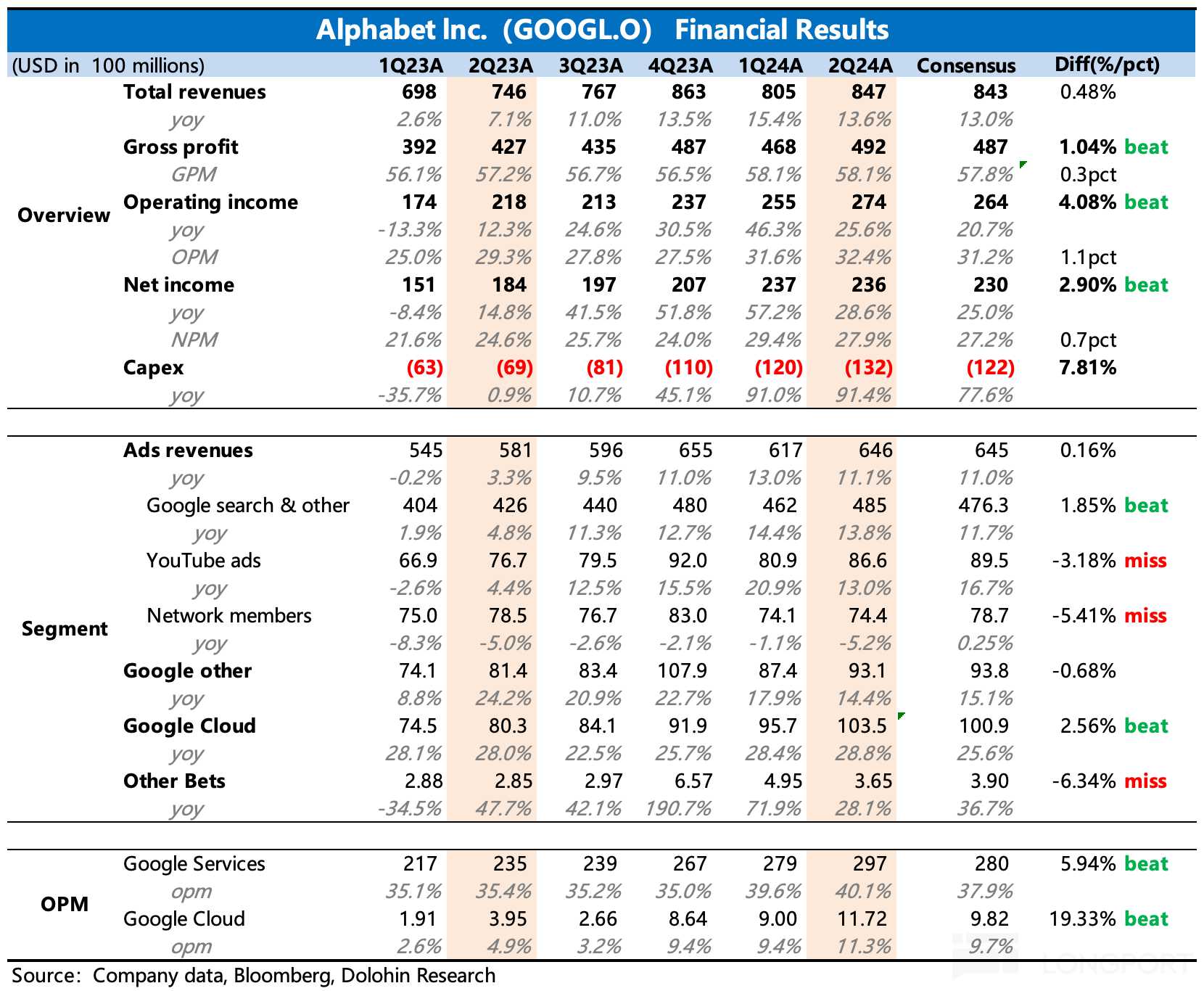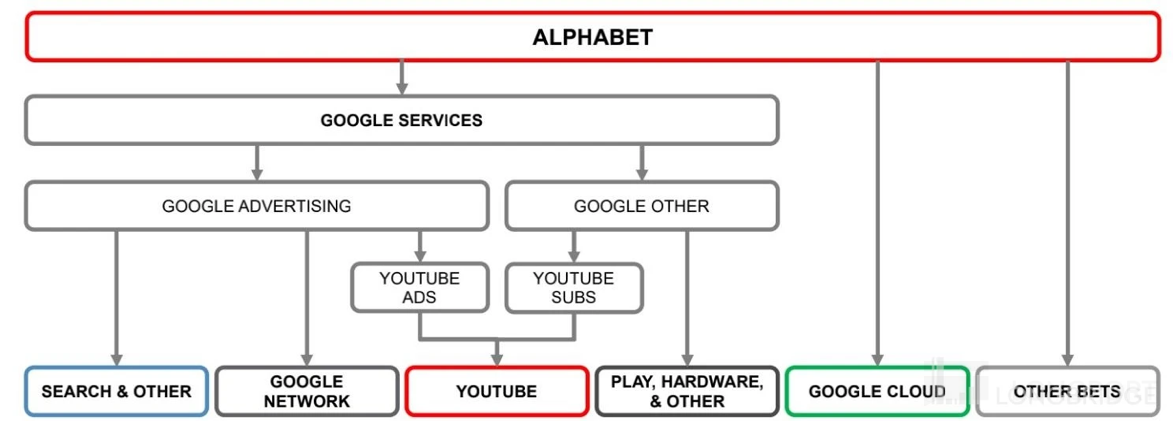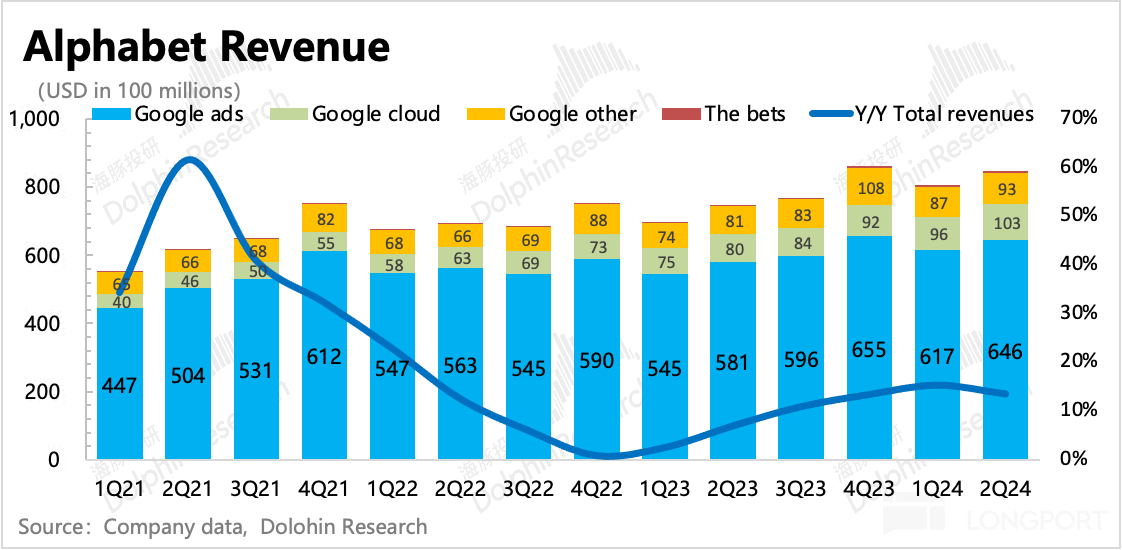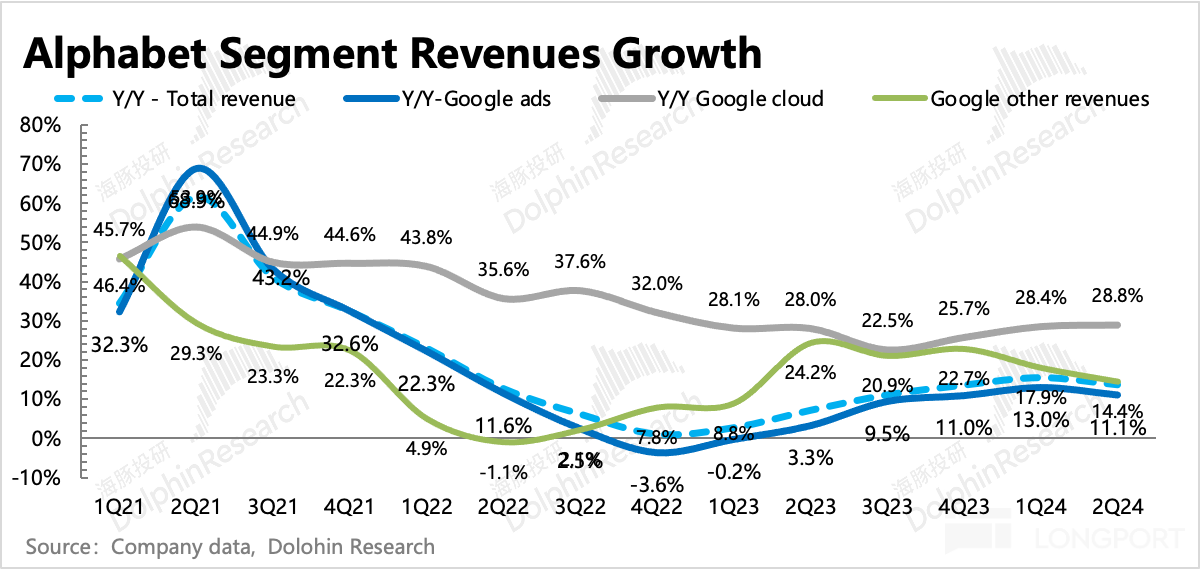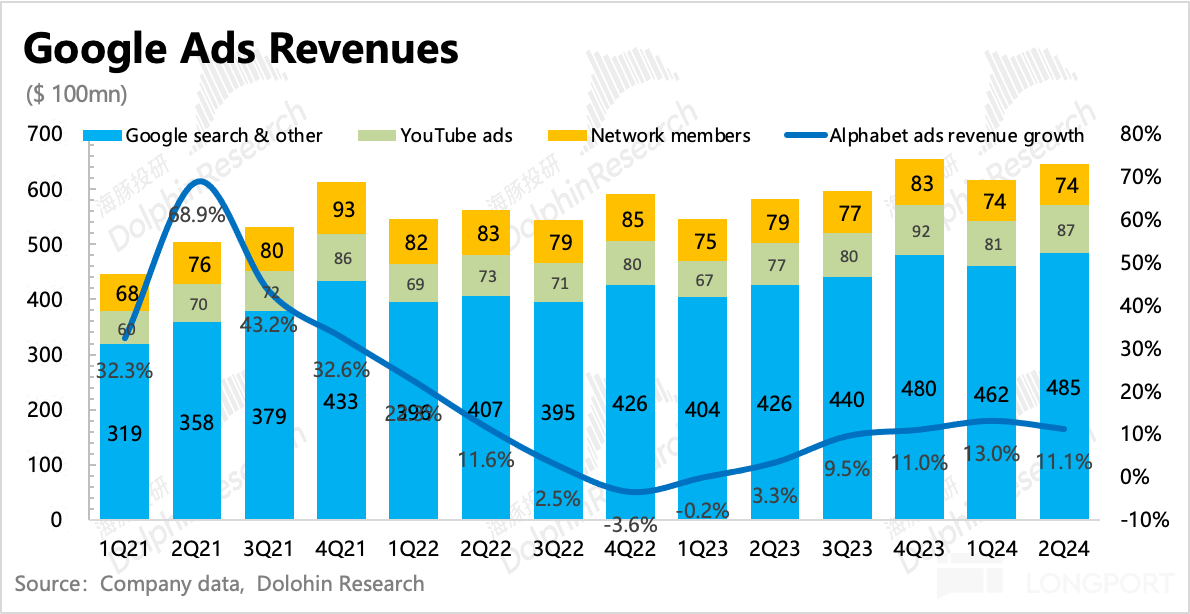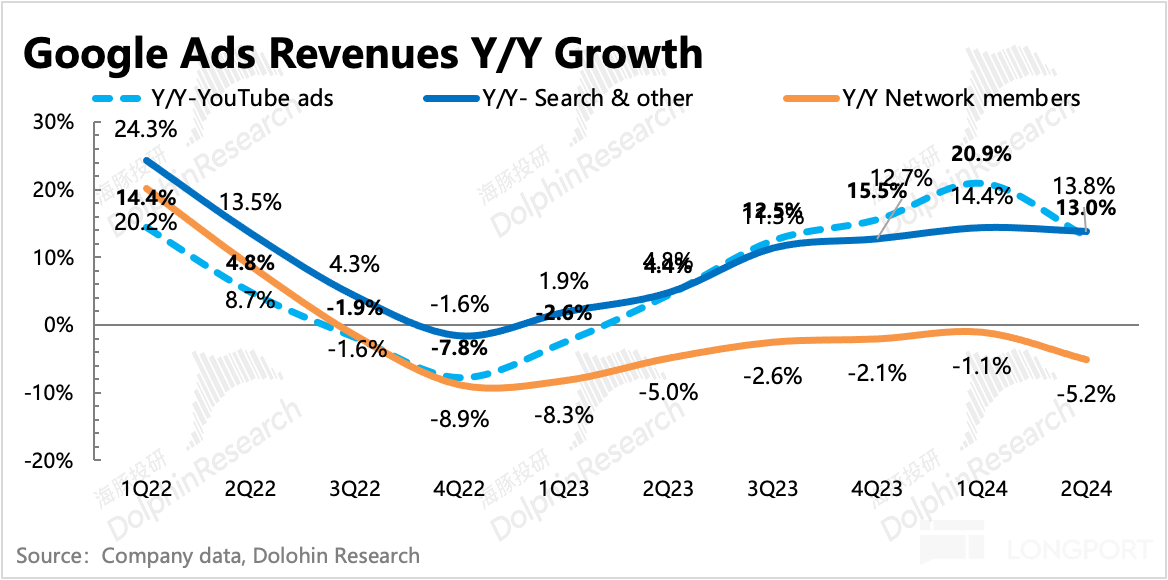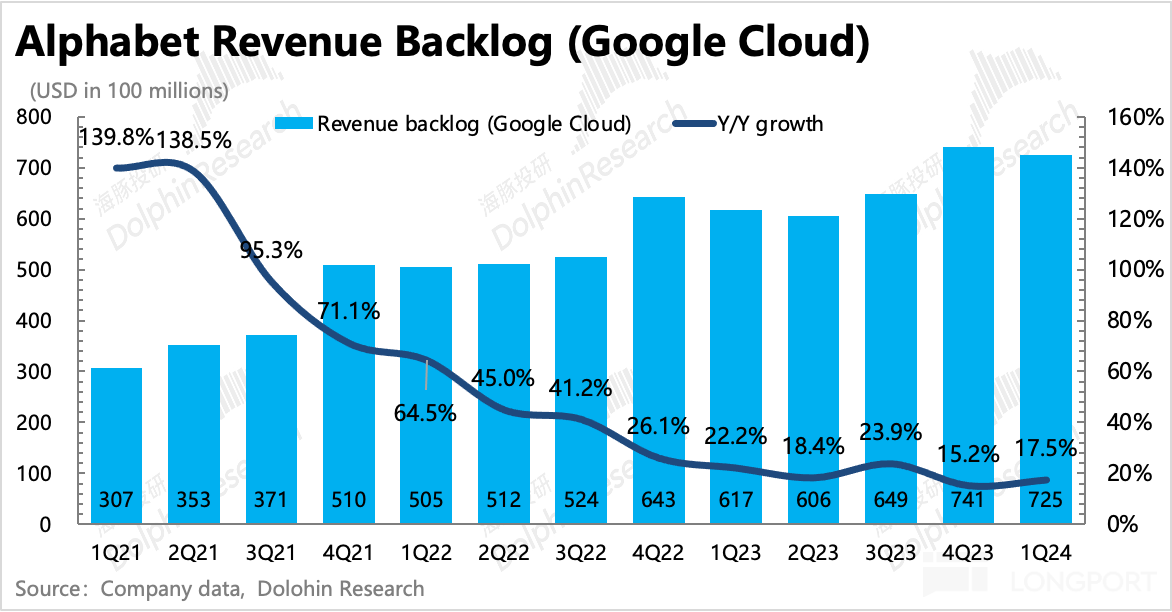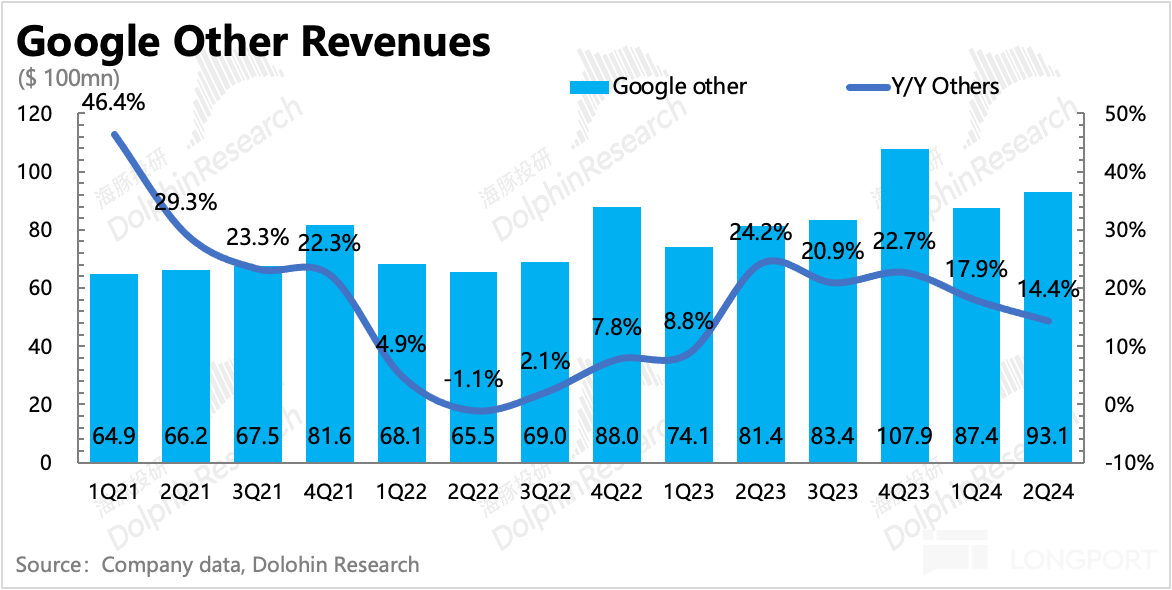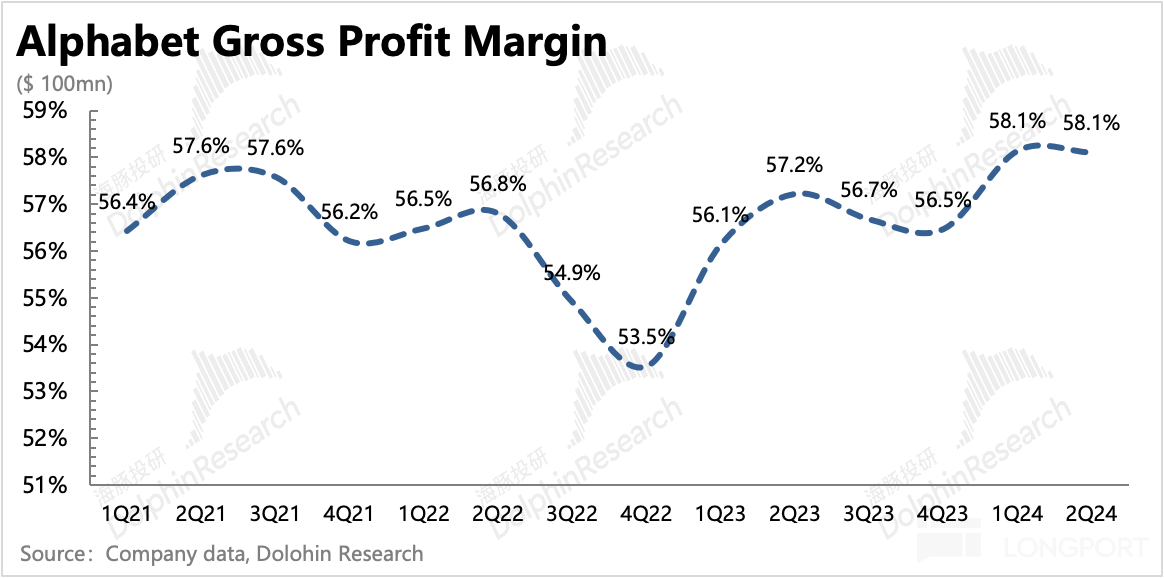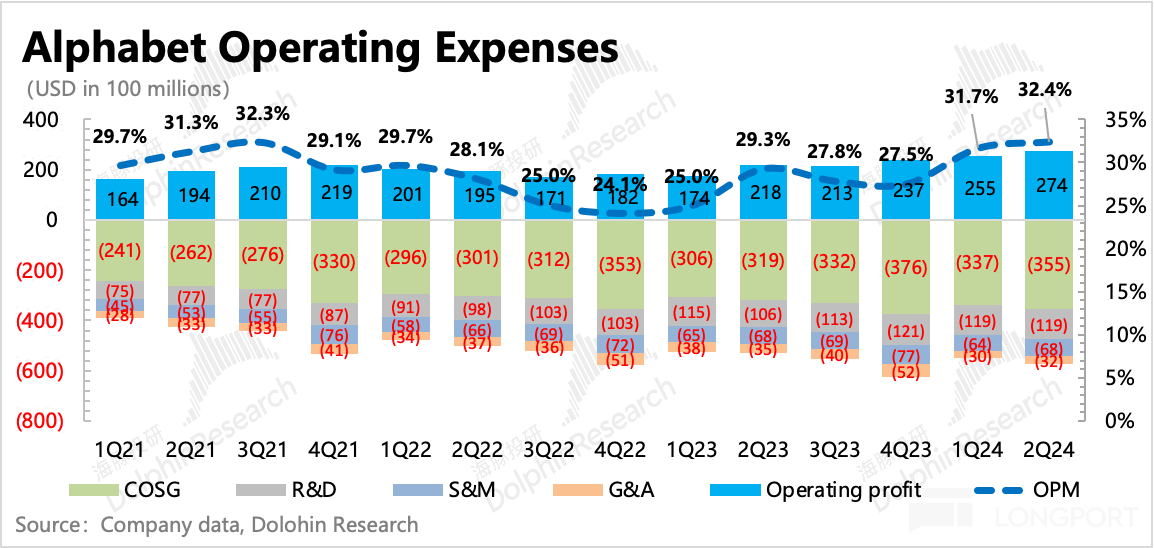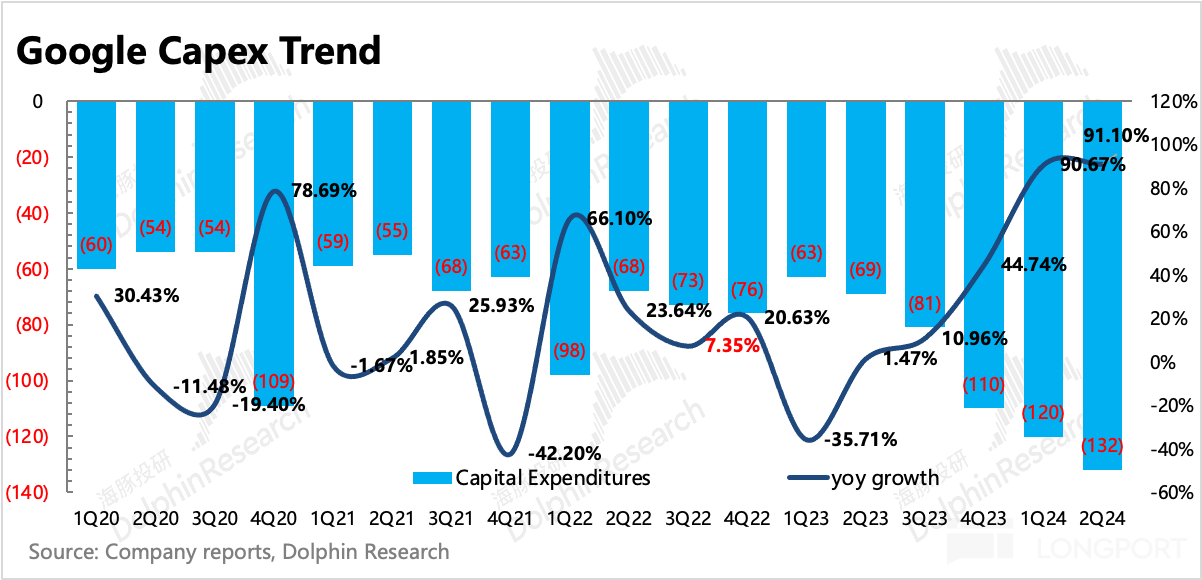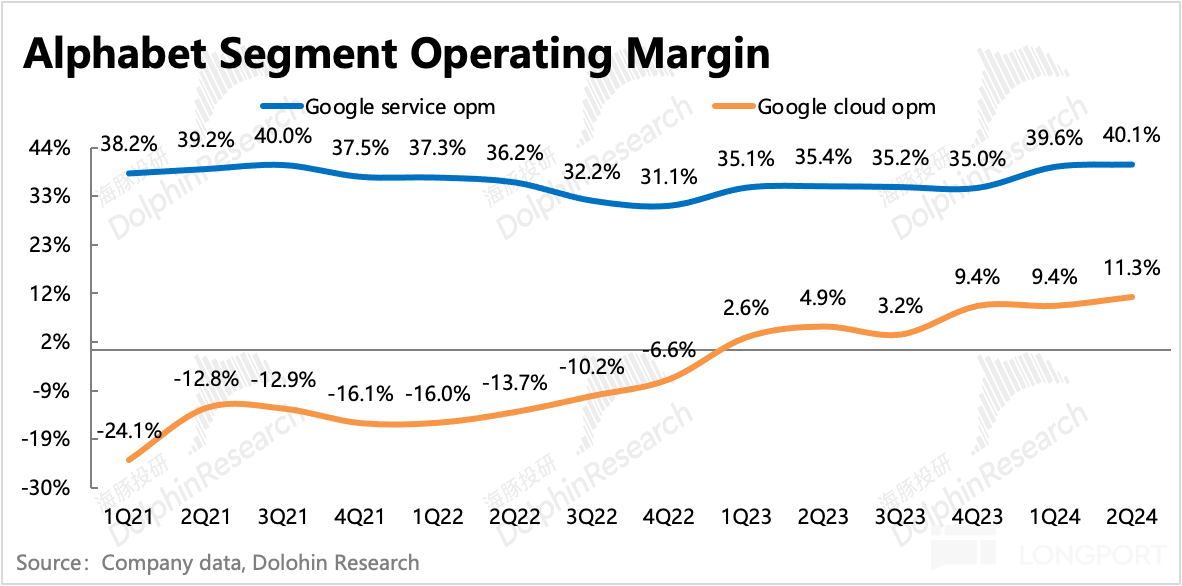
 Likes Received
Likes Received Posts
Posts360-degree comprehensive scrutiny, is Google really that stable?

After the market closed on July 23, Eastern Time, Google's parent company $Alphabet(GOOGL.US) released its financial report for the second quarter of 2024. This "mixed" financial report may not receive too much positive feedback from the market given the current high valuation background.
In interpreting Google's financial report this time, Dolphin will discuss the most concerning and core issues affecting Google's valuation based on the content of the conference call.
Specifically:
1. Overall, what are the positives and negatives in the Q2 report?
The positives are (1) stronger-than-expected growth in search advertising and cloud services; (2) revenue slightly exceeding profit expectations due to optimized traffic costs and expense reduction from layoffs.
However, the negatives are (1) significantly lower-than-expected performance of YouTube advertising, which the market had high expectations for; (2) capital expenditures exceeding market expectations, leading to concerns about future profit margins.
2. Why is search strong and YouTube weak?
The growth in search advertising comes from strong demand in specific industries such as retail and financial services, as well as the pull of PMax for retail e-commerce advertising.
As for the slowdown in YouTube advertising growth, management attributes it to a high base effect in Q2, which stems from Asia-Pacific retailers starting to advertise on YouTube in Q2 of the previous year, and this year's Q2 marks the end of the high base period.
Dolphin believes that the base effect alone cannot explain everything. There may be a more sustained impact from consumer time shifting to short videos, with external competition from Reels, TikTok, competition from Netflix and Amazon for YouTube TV ads, and more internal traffic shifting to Shorts. However, the monetization capability of Shorts is not as strong as mid-roll ads in long videos, which drags down overall growth.
3. How did profit exceed expectations?
Google's revenue in the second quarter merely met expectations, so the good profit performance comes from cost optimization. Specifically, cost optimization is mainly reflected in traffic costs, while expense optimization mainly includes reduced layoffs and legal expenses, thereby compressing management expenses.
From a business perspective, the operating profit margin of Google Services increased by 0.5 percentage points. Google Cloud business also resumed a pace of profit improvement, with a 2 percentage point increase in OPM compared to the previous quarter. Although the market expected further improvement in both areas due to concerns about AI cost increments before the financial report, they are not considered high.
4. Is the marginal weakening of future profit margins expected?
In recent quarters, the operating profit margin of Google Services has continued to rise to around 40%, seemingly without seeing the impact of AI cost investment. Is the market overly concerned? Dolphin believes that the lag in the recognition of related costs is not as significant.
In fact, in Q2, it is already clear that R&D expenses are accelerating again. At the same time, capital expenditures have exceeded market expectations, and it is expected that the budget for the second half of the year will still maintain a quarterly amount of over 12 billion.
Moreover, the most direct indication from the company's conference call is that the number of employees will see a slight expansion in the third quarter, and the operating profit margin will be affected by the infrastructure depreciation costs that have been increasing over the past few quarters.
5. Revenue Outlook for the Second Half of the Year?
The company did not provide much description of the revenue outlook for the second half of the year, mainly emphasizing the impact of a high base. Dolphin predicts that there will be some pressure on the growth rate of advertising revenue in the second half of the year. In addition to the base effect, the macro environment in the U.S. is showing signs of weakening, and there will also be the impact of reduced cross-border e-commerce advertising in China.
On the other hand, cloud business is expected to continue to maintain high growth under a low base and increasing demand for AI (significant AI increment only this year). However, advertising revenue accounts for a large portion of the revenue, so overall revenue will tend to align with the performance of advertising revenue.
6. Implementation of the Shareholder Rewards Package Announced Last Quarter?
Last quarter, Google announced a new $70 billion repurchase authorization + first-time dividend payout package. In the second quarter, they actually repurchased $15.7 billion, paid a dividend of $0.2 per share, and announced that they will continue to pay the same dividend next quarter. Based on this repurchase and dividend pace, the expected annualized return from repurchase and dividends is 3%.
7. Key Indicators and Expectations Comparison

Dolphin's Viewpoint
In the still relatively strong macro environment in the second quarter, the performance of advertising giants is unlikely to be poor, with the performance of search ads and YouTube ads offsetting each other.
The poor performance of YouTube ads can be attributed to specific reasons, but why search ads are strong is not clearly understood by the market. The company explains that the improvement in ad performance is driven by Performance Max and AI-powered search ads. Based on this factor, the company is very optimistic about the growth prospects of the search business after officially launching AI overview (formerly SGE) at the May I/O conference.
There are diverse opinions on how much AI can contribute to the growth of advertising giants, not only for Google but also for Meta. Especially when there is no significant gap in levels between giants at the current stage, it becomes even more difficult to achieve stable and continuous quantifiable effects, especially in tracking the pure incremental effects brought by AI. Moreover, for Google, the direct impact of Gen-AI on advertising driving, as shown by the AI overview launched in mid-May in the U.S., will not be reflected in advertising budgets so quickly. (Previously, in terms of management's perspective on "benefiting from AI," Dolphin believes that it actually refers to PMax. Essentially, PMax's attractiveness lies in integrating the advertising delivery systems of different internal platforms, as well as providing advertisers with a fully automated delivery experience, but it is not directly driven by this round of generative AI.)
However, regardless of how it is attributed, if Google is viewed as a holistic ecosystem (under PMax, it is an internally unified advertising system), then the factors affecting Google's overall advertising revenue can be simplified to 1) industry/macro; 2) competition. The issue is that, from an expected perspective, there are currently no significant (market-unexpected) potential positives for Google in the second half of the year.
1) On a macro level, there may currently be a crossroads, with ongoing disputes, potential weakening at the margin, or the possibility of holding steady without further deterioration, but the probability of further upside is not high. The incremental impact brought to the industry by China's cross-border e-commerce is clearly slowing down and weakening this year, meaning the entire industry will face the impact of a high base in the second half of the year.
2) In terms of competition, search needs to deal with Apple's default search engine antitrust lawsuit, as well as Apple's resistance to the Chrome browser (to mitigate the risk of the default search engine being removed, Google is guiding Apple users to download and use Chrome, directly affecting Safari and causing Apple's dissatisfaction). YouTube also needs to face competition from other short video platforms (Reels, TikTok), connected TVs (Amazon TV, Netflix), etc.
Perhaps the optimization effects of AI on internal advertising tools will be reflected in Google's trend of squeezing the market share of small and medium platforms. However, small and medium platforms inherently have small market shares, and if they cannot shake the market shares of other giants, looking at this pure increment, especially for Google's scale, is not particularly exciting.
Furthermore, while revenue is under pressure, AI investment needs to remain high. Capital expenditures in the second quarter exceeded previous guidance and market expectations, but for the second half of the year, the company did not reduce the budget due to the excess in Q2, with at least 49.2 billion for the whole year, a year-on-year growth rate of 52%. In the third quarter, operating profit margins will begin to face incremental cost confirmations from front-loaded investments, meaning that a mismatch between short-term AI investment and output will put pressure on profit margins.
The impact of marginal changes in fundamentals needs to be considered in conjunction with valuation. Currently, Google's market value implies a 20x PE over 25 years, 15x EV/EBITDA, which is at a historical median level, neither high nor low. However, significant valuation uplift requires a clear driver on the EPS side. Considering the short-term marginal risks mentioned above, Dolphin believes that the current position does not offer good value for money. It may be worth paying attention to the progress of the third-quarter Apple default search engine lawsuit, and whether a safer position can be seen when it triggers market value fluctuations.
Below is a detailed interpretation of the financial report
I. Introduction to Google
Alphabet, Google's parent company, has a diverse business portfolio, and its financial reporting structure has changed multiple times. For those unfamiliar with Alphabet, it is recommended to first understand its business architecture


Briefly explain the long logic of Google's fundamentals:
a. Advertising business, as the main revenue source, contributes the majority of the company's profits. The crisis of search advertising being eroded by feed ads in the medium to long term is being supplemented by the high-growth streaming media platform YouTube.
b. Cloud business is the company's second growth curve, having turned losses into profits and showing strong recent momentum in contract signings over the past year. As advertising continues to be dragged down by weak consumer spending, the development of the cloud business is becoming increasingly important in supporting the company's performance and valuation imagination.
II. Overall Revenue Meets Expectations
In the second quarter, Google's total revenue reached 84.7 billion, a year-on-year increase of 13.6%, basically meeting market expectations.
Due to the low base in the second quarter, a strong macroeconomic backdrop, and active vertical sectors where search ads are mainly placed, overall advertising revenue has maintained relatively stable growth.
At the same time, under the AI wave, Google Cloud services have achieved high growth as expected. Subscription revenue from YouTube has performed well, driving sustained high growth in other service revenues.


(1) Advertising: Search Continues to Exceed Expectations, YouTube Unexpectedly Weakens
Advertising revenue in the second quarter was 64.6 billion, with an overall growth of 11%. Due to the impact of the high base brought by cross-border e-commerce advertising in China in Q2 of last year, the growth rate has slightly slowed compared to the first quarter. Although it generally meets expectations, the contribution mainly comes from search advertising, while YouTube's performance is mediocre, and alliance advertising revenue continues to deteriorate.
a. Search Advertising
The growth of search advertising comes from strong demand for placements in industries such as retail and financial services. However, the reason behind the strength of search advertising is not clearly understood by the market. The company explains that the improvement in advertising effectiveness is driven by Performance Max and AI search. Based on this factor, after officially launching AI overview (formerly SGE) at the May I/O conference, the company is also very optimistic about the growth prospects of the search business.
b. YouTube Advertising
As for the slowdown in the growth rate of YouTube advertising, the management attributes it to the high base issue in Q2, which originated from Asia-Pacific retailers starting to advertise on YouTube in Q2 of last year, and this year's Q2 coincided with the end of the base dividend period。
Dolphin believes that the base issue cannot explain everything, speculating that there is a more sustained impact of C-end time shifting to short videos. On one hand, there is external competition from Reels and TikTok, while on the other hand, more internal traffic on YouTube is tilting towards Shorts. However, Shorts' monetization capability is not as good as mid-to-long videos with bumper ads, which means internal erosion is dragging down overall growth.
Additionally, YouTube TV may also be affected by Netflix and Amazon Prime. Although YouTube TV has a continuous advantage in viewership share, Netflix and Amazon Prime TV have not previously focused on ad monetization, so there hasn't been competition in ads in the past. But now YouTube TV also needs to step up to the challenge.
c. Network Alliance Advertising
Alliance advertising revenue declined by 5.2% in the second quarter, showing poor performance. The weakening trend over multiple quarters implies a judgment on an industry trend: In the AI wave, having AI technology does not necessarily mean that a company can achieve significant growth, but not having it will lead to a decline in market share. Therefore, in this round of technological innovation, the technological advantage of giants will further squeeze the market share of small and medium platforms.
The plan to gradually stop using third-party cookies starting in the third quarter has been temporarily shelved, probably due to too much resistance from websites and advertising agencies. The company will adopt a way to provide users with the choice of allowing cookie tracking, which may delay the worsening trend in the next quarter.


(2) Cloud: Achieved revenue of 10.3 billion in the second quarter, with a year-on-year growth rate of 28.8%, showing a very stable high growth trend.
Cloud business clearly perceives the pull of AI on revenue. The company mentioned that the revenue from the AI part has reached several billion levels, and the speed of this proportion increase is very fast, indicating that enterprise customers are quite positive about adopting AI cloud. As of the second quarter, Google's AI infrastructure and GenAI solutions provided to cloud customers have generated billions of dollars in revenue, used by over 2 million developers.
In addition, the high growth of the cloud department is still driven by Google Workspace.

Cloud business is To B, so the long-term trend may be related to the competitiveness of its own products, but short-term changes are more likely to be influenced by changes in the size of new contracts in the current or previous period。
Therefore, Dolphin Jun generally uses Google's Revenue Backlog indicator to judge short-term trends. Most of this indicator comes from cloud business, so its trend can also be seen as the trend of the backlog of cloud business contracts.
As of the first quarter (second quarter data needs to wait for the complete quarterly report submitted to the SEC, although the data is lagging, the overall trend can still be seen), Google Cloud's backlog contract size is on a relatively stable upward trend. It grew by 17.5% year-on-year, with a slight acceleration compared to the previous quarter, and a net increase of 8 billion quarter-on-quarter, lower than the 18.4 billion in the fourth quarter, mainly due to seasonal fluctuations.

(3) Other Businesses: The growth rate further slowed down in the second quarter, with a year-on-year growth of 14%. This part of the revenue mainly consists of YouTube subscriptions (TV, music, etc.), Google Play, Google, One, hardware (Pixel phones and Nest smart home devices), etc.
The growth support in the past two quarters came from YouTube subscriptions. In the second quarter of last year, YouTube raised its membership fees, but TV viewership share continued to increase steadily, maintaining a high growth trend in subscription revenue. However, the base effect brought by the price increase ended after the second quarter, so other businesses are also facing high base pressure.


III. Capital Expenditure Exceeds Expectations Again, Subsequent Profit Margins May Be Affected
The operating profit of the core main business in the second quarter was 27.4 billion, a year-on-year increase of 26%, with a profit margin of 32.4%, an increase of 1 percentage point quarter-on-quarter. The slight optimization is mainly due to cost compression. On one hand, legal expenses decreased year-on-year, and on the other hand, the group continued to net reduce 1,313 employees, ultimately reflected in a 9.3% year-on-year decrease in management expenses. Although there was optimization in traffic costs, the increase in other costs offset the increase in gross profit margin.



Other expenses show increasing signs or trends:
(1) The market is most concerned about changes in capital expenditures. In the second quarter, capital expenditures were 13.2 billion, both higher than the company's rough guidance of over 12 billion and the market's expectation of 12.5 billion. During the conference call, the company did not adjust the budget guidance for capital expenditures in the second half of the year due to the higher investment in the second quarter, which remains in the range of over 12 billion. This means that the full-year capital expenditures for 2024 will be at least 49.2 billion, a year-on-year increase of 52%.

(2) Research and development expenses are also showing an increasing trend. R&D expenses in the second quarter increased by 12% year-on-year, further accelerating from the 4% growth rate in the first quarter.
Profitability by business segment:
Google Services and Google Cloud, the two main business departments with advertising as the main focus, both saw an increase in operating profit margins in the second quarter. The profitability improvement in the cloud department significantly exceeded market expectations, and the operating profit margin of Google Services also slightly increased to a new high in nearly three years.
However, as more AI infrastructure depreciation will be recognized as cost expenses in the third quarter, the impact of AI misalignment period will increase, so the profit margins of both major businesses may face certain adjustment pressures.

Dolphin Research on "Google" Historical Collection:
Financial Reports Season
April 26, 2024 Conference Call "Google: Outlook on Profit Margin Expansion, Quarterly Capital Expenditures Higher than Q1 (1Q24 Conference Call Summary)" Link
April 26, 2024 Financial Report Review "Google Soaring? Learning from Meta, Striving to be the Best" Link
January 31, 2024 Conference Call "AI Management Efficiency, AI Product Innovation, AI Expenditure Investment... (Google 4Q23 Conference Call Summary)" Link
January 31, 2024 Financial Report Review "Google: Expectations Too Enthusiastic, Top Player Pours Cold Water" Link 2023 年 10 月 25 日电话会《Google: Cloud slowdown due to enterprise customer Capex optimization, signs of stabilization seen (3Q23 earnings call summary)》
2023 年 10 月 25 日财报点评《Google: Ads still dominate, cloud slowdown due to "AI not working"?》
2023 年 7 月 26 日电话会《Google: Investing in AI, benefiting from AI (2Q23 earnings call summary)》
2023 年 7 月 26 日财报点评《Google: Breaking doubts, can the ad leader turn the tide?》
2023 年 4 月 26 日电话会《AI competition never stops, focus on search and cloud (Google 1Q23 earnings call summary)》
2023 年 4 月 26 日财报点评《Google: Beating expectations against the trend? Joy mixed with concerns》
2023 年 2 月 3 日财报点评《Focus on revenue growth rather than simply cutting costs (Google 4Q22 earnings call summary)》
2023 年 2 月 3 日财报点评《Facing significant short-term pressure, Google needs to learn from Meta》
2022 年 10 月 26 日电话会《Short-term resource optimization, opportunities lie in search and YouTube (Google 3Q22 earnings call summary)》
2022 年 10 月 26 日财报点评《Google: Decline approaching, ad leader already on the decline》2022 July 27th Conference Call "Google: Economic High in the Second Half of the Year with 'Uncertainty', Focused Investment in Areas with Better Long-Term Prospects (Conference Call Summary)"
2022 July 27th Financial Report Review "Google: 'Tough Performance' Amidst Expectations of a Storm"
2022 April 27th Conference Call "Management Avoids Talking About TikTok, But Emphasizes Intensifying Competition Behind the Focus on Shorts (Google Conference Call Summary)"
2022 April 27th Financial Report Review "Google: Facing Continuous Headwinds, Big Brother Struggles"
2022 February 2nd Conference Call "Increasing Investment, Accelerating Hiring, Google Actively Seeking Expansion (Conference Call Summary)"
2022 February 2nd Financial Report Review "Dazzling Performance, Rare Stock Split, Google Ready to Soar Again"
In-Depth
2023 December 20th "Google: Gemini Can't Solve the 'Little Ghost' Troubles, Next Year Won't Be Easy"
2023 June 14th "In-Depth Article: Is ChatGPT the 'Thanos Snap' Killing Google?"
2023 February 21st "US Stock Ads: After TikTok, Will ChatGPT Spark a New 'Revolution'?"
2022 July 1st "TikTok to Teach 'Big Brothers' How to Work, Google, Meta to Change the Game"
2022 February 17th "Internet Advertising Overview - Google: Watching the Storm Rise" February 22, 2021 "Dolphin Research: Breaking Down Google - Has the Recovery Trend of the Advertising Leader Ended?"
November 23, 2021 "Google: Performance Soaring Along with Stock Price, Strong Recovery Dominates the Year"
Risk Disclosure and Disclaimer for this Article: Dolphin Research Disclaimer and General Disclosure
The copyright of this article belongs to the original author/organization.
The views expressed herein are solely those of the author and do not reflect the stance of the platform. The content is intended for investment reference purposes only and shall not be considered as investment advice. Please contact us if you have any questions or suggestions regarding the content services provided by the platform.

